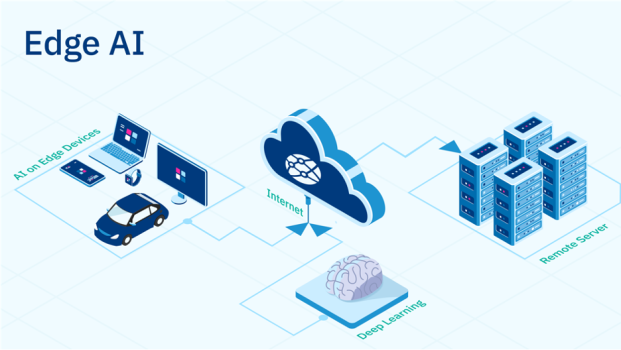K
Kathleen Martin
Guest
The use of AI in digital transformation has significantly impacted almost every industry. Business leaders use AI and machine learning to optimize operations, improve customer experience and reduce costs.
Alongside advancement in AI, the emergence of edge computing has been instrumental in allowing companies to have their data analyzed and processed at the Edge itself. Edge is a distributed computing model that brings computation, data storage, and power closer to an event's point of action or occurrence.
Edge computing has become a critical component of the Industrial Internet, underpinning the development of smart cities and smart factories. Edge computing supports smart cities with sensors on traffic lights and other public utilities that can directly interact with smartphones through apps. It also supports smart factories, where machinery has sensors that give real-time information about machinery performance and conditions. With such increasing complexity of tasks to be handled at the edge devices, the ability to deploy AI on the Edge has spawned and burgeoned over the recent years.
Previously, machine learning and deep learning models could not be trained and deployed in edge devices. However, with the influx of higher computation, the capacity to handle different AI-optimized workloads on such edge devices has exploded widely in recent years. This has also allowed for a greater degree of privacy and security and the opportunity to have data processed in real-time.
Devices can be small. Examples include smart thermostats, smart doorbells, home cameras or cameras on automobiles, and augmented reality or virtual reality glasses. Devices can also be large, such as industrial robots, cars, smart buildings, and oil platforms. These Edge AI devices capable of running an optimized AI on their system include self-driving vehicles, autonomous bots, AI-driven vacuum cleaners to drones, and smartphones to surveillance cameras. Hence, with of power of Edge and AI, devices and machines can interpret, learn, and make decisions instantaneously.
Since the data doesn't have to fetch the model output from the cloud, the data collection, preprocessing, and analysis can occur in near real-time. Hence, when AI models are deployed on Edge relative to the cloud, we enable such Edge AI devices to speed up decision-making, reduce latency manifolds, make data processing more secure, and provide a better and optimized user experience overall.
Edge computing built on AI is expected to impact many industries significantly. IDC (International Data Corporation) estimates that we will see the number of intelligent edge devices in the market grow to 150 billion by 2025. While some edge computing is being applied today, it is poised for explosive growth in the future. With the continued growth of the IoT, Gartner predicts that 75% of enterprise-generated data will be created and processed outside the traditional data center or cloud by 2025. The global edge computing market, valued at USD3.5 billion in 2019, could reach USD43.4 billion by 2027. This indicates that the AI computation on such devices will be burgeoning at an exponential pace enabling users to interact with processed data at the source in a secure and optimized fashion.
Continue reading: https://www.cdotrends.com/story/16179/ai-edge-enabling-digital-transformation
Alongside advancement in AI, the emergence of edge computing has been instrumental in allowing companies to have their data analyzed and processed at the Edge itself. Edge is a distributed computing model that brings computation, data storage, and power closer to an event's point of action or occurrence.
Edge computing has become a critical component of the Industrial Internet, underpinning the development of smart cities and smart factories. Edge computing supports smart cities with sensors on traffic lights and other public utilities that can directly interact with smartphones through apps. It also supports smart factories, where machinery has sensors that give real-time information about machinery performance and conditions. With such increasing complexity of tasks to be handled at the edge devices, the ability to deploy AI on the Edge has spawned and burgeoned over the recent years.
Previously, machine learning and deep learning models could not be trained and deployed in edge devices. However, with the influx of higher computation, the capacity to handle different AI-optimized workloads on such edge devices has exploded widely in recent years. This has also allowed for a greater degree of privacy and security and the opportunity to have data processed in real-time.
Devices can be small. Examples include smart thermostats, smart doorbells, home cameras or cameras on automobiles, and augmented reality or virtual reality glasses. Devices can also be large, such as industrial robots, cars, smart buildings, and oil platforms. These Edge AI devices capable of running an optimized AI on their system include self-driving vehicles, autonomous bots, AI-driven vacuum cleaners to drones, and smartphones to surveillance cameras. Hence, with of power of Edge and AI, devices and machines can interpret, learn, and make decisions instantaneously.
Since the data doesn't have to fetch the model output from the cloud, the data collection, preprocessing, and analysis can occur in near real-time. Hence, when AI models are deployed on Edge relative to the cloud, we enable such Edge AI devices to speed up decision-making, reduce latency manifolds, make data processing more secure, and provide a better and optimized user experience overall.
Edge computing built on AI is expected to impact many industries significantly. IDC (International Data Corporation) estimates that we will see the number of intelligent edge devices in the market grow to 150 billion by 2025. While some edge computing is being applied today, it is poised for explosive growth in the future. With the continued growth of the IoT, Gartner predicts that 75% of enterprise-generated data will be created and processed outside the traditional data center or cloud by 2025. The global edge computing market, valued at USD3.5 billion in 2019, could reach USD43.4 billion by 2027. This indicates that the AI computation on such devices will be burgeoning at an exponential pace enabling users to interact with processed data at the source in a secure and optimized fashion.
Continue reading: https://www.cdotrends.com/story/16179/ai-edge-enabling-digital-transformation

